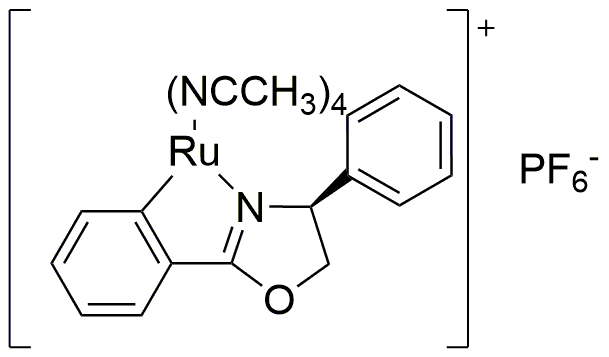Ru(II)-(S)-Pheox catalyst is widely utilized in research focused on:
- Asymmetric Synthesis: This catalyst plays a crucial role in producing chiral compounds, which are essential in pharmaceuticals. Its ability to facilitate enantioselective reactions makes it invaluable for creating drugs with specific activity profiles.
- Catalytic Reactions: It is employed in various catalytic processes, including hydrogenation and oxidation. This enhances reaction efficiency and reduces the need for harsh conditions, making it a preferred choice in organic synthesis.
- Green Chemistry: The catalyst supports environmentally friendly practices by enabling reactions that minimize waste and energy consumption. This is particularly beneficial in industries aiming for sustainable production methods.
- Material Science: In the development of advanced materials, Ru(II)-(S)-Pheox is used to facilitate polymerization reactions, leading to innovative materials with tailored properties for electronics and coatings.
- Research and Development: It serves as a key component in academic and industrial research, helping scientists explore new reaction pathways and develop novel compounds, thereby advancing the field of synthetic chemistry.
General Information
Properties
Safety and Regulations
Applications
Ru(II)-(S)-Pheox catalyst is widely utilized in research focused on:
- Asymmetric Synthesis: This catalyst plays a crucial role in producing chiral compounds, which are essential in pharmaceuticals. Its ability to facilitate enantioselective reactions makes it invaluable for creating drugs with specific activity profiles.
- Catalytic Reactions: It is employed in various catalytic processes, including hydrogenation and oxidation. This enhances reaction efficiency and reduces the need for harsh conditions, making it a preferred choice in organic synthesis.
- Green Chemistry: The catalyst supports environmentally friendly practices by enabling reactions that minimize waste and energy consumption. This is particularly beneficial in industries aiming for sustainable production methods.
- Material Science: In the development of advanced materials, Ru(II)-(S)-Pheox is used to facilitate polymerization reactions, leading to innovative materials with tailored properties for electronics and coatings.
- Research and Development: It serves as a key component in academic and industrial research, helping scientists explore new reaction pathways and develop novel compounds, thereby advancing the field of synthetic chemistry.
Documents
Safety Data Sheets (SDS)
The SDS provides comprehensive safety information on handling, storage, and disposal of the product.
Product Specification (PS)
The PS provides a comprehensive breakdown of the product’s properties, including chemical composition, physical state, purity, and storage requirements. It also details acceptable quality ranges and the product's intended applications.
Certificates of Analysis (COA)
Search for Certificates of Analysis (COA) by entering the products Lot Number. Lot and Batch Numbers can be found on a product’s label following the words ‘Lot’ or ‘Batch’.
*Catalog Number
*Lot Number
Certificates Of Origin (COO)
This COO confirms the country where the product was manufactured, and also details the materials and components used in it and whether it is derived from natural, synthetic, or other specific sources. This certificate may be required for customs, trade, and regulatory compliance.
*Catalog Number
*Lot Number
Safety Data Sheets (SDS)
The SDS provides comprehensive safety information on handling, storage, and disposal of the product.
DownloadProduct Specification (PS)
The PS provides a comprehensive breakdown of the product’s properties, including chemical composition, physical state, purity, and storage requirements. It also details acceptable quality ranges and the product's intended applications.
DownloadCertificates of Analysis (COA)
Search for Certificates of Analysis (COA) by entering the products Lot Number. Lot and Batch Numbers can be found on a product’s label following the words ‘Lot’ or ‘Batch’.
*Catalog Number
*Lot Number
Certificates Of Origin (COO)
This COO confirms the country where the product was manufactured, and also details the materials and components used in it and whether it is derived from natural, synthetic, or other specific sources. This certificate may be required for customs, trade, and regulatory compliance.


